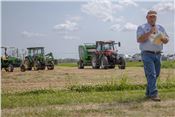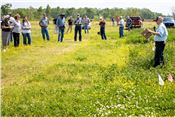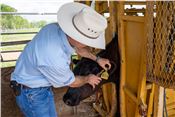Dean Lee Beef, Forage Field Day Focuses On Managing A Changing Market
V. TODD MILLER
ALEXANDRIA, LOUISIANA
The LSU AgCenter Dean Lee Research and Extension Center brought researchers and producers together with a focus on navigating an ever- evolving cattle market during its annual beef and forage field day.
Despite the heat and overcast skies, the afternoon event kicked off with a discussion of field clover – both its use in winter pasture systems and controlling broadleaf weed infestation in clover-covered areas.
AgCenter forage specialist Ed Twidwell discussed clover and why producers might be interested in planting it for forage and grazing.
“I know all of you are concerned with the high prices of nitrogen fertilizer this year,” Twidwell said. “By incorporating various clovers into your forage program, you may be able to cut out the need for adding nitrogen fertilizer. Most of the annual clovers produce anywhere from 50 to 75 pounds of nitrogen per acre.”
Twidwell said some clovers can extend the grazing season into June and even July with timely rainfall. But, he added, clover doesn’t do well in low-pH, acidic soils.
Following Twidwell, AgCenter turfgrass specialist Ron Strahan discussed herbicides to combat broadleaf weeds in clover.
“We applied 2,4-D about a month ago at a quart per acre, and the amount of injury was minimal,” Strahan said. “We’re only talking about white clover here. With other types of clover, you’re going to kill it.”
The second field stop revolved around producing and feeding baleage with AgCenter agent Vince Deshotel. Baleage, or bale silage, is the silage crop resulting from full-length forage that has been wilted in the field to about 50 percent moisture, baled and wrapped with stretch plastic to exclude oxygen.
“We cut the hay that you see yesterday at about 54 percent moisture, which is right around where it needs to be to complete the fermentation process to make the feed quality you’re targeting when wrapping it,” Deshotel said.
The final field stop was a talk on the importance of identification systems for cattle, including improving recordkeeping, electronic identification and brand registrations.
Dean Lee research associate Jeff Gurie presented information on electronic identification systems, known as EIDs, which can track a cow’s health history since birth. He said that proper identification is a way to assure consumers that the beef products they choose are safe.
“You can’t just look at a herd and tell if they’re healthy or not,” Gurie said. “The general public likes to know that we’re keeping records of a cow’s history. It makes them feel safer about buying our product.”
The day ended inside the State Evacuation Shelter with regional and market updates from Tara Smith, AgCenter Central Region director, and Kurt Guidry, AgCenter Southwest Region director.
Smith commented on sustaining and increasing the beef cattle research and outreach focus at Dean Lee.
“We are investing in our faculty and infrastructure with a goal of helping to sustain our clientele for years to come,” she said.
Guidry, an economist, closed out the event with an optimistic outlook on the current cattle market, emphasizing that lower cattle inventory numbers along with strong domestic and export demand for beef has provided a solid foundation for cattle prices.
“In general, my view of the market outlook for beef cattle is that we have seen an increase in feeder cattle and calf prices as the fundamental supply and demand situation has improved,” Guidry said.
“Drought conditions in many parts of the U.S. have likely increased the rate of liquidation of cattle herds and pushed more cattle through the marketing channel than would have been anticipated at this time of the year.”
Larger-than-expected cattle numbers are being processed and on feed, which means there will likely be more beef production in the short term. But, Guidry added, it also means there will likely be even tighter cattle supplies later in the year and into next year.
That provides a positive long-term outlook for cattle prices, he said.
“From a cattle numbers perspective, we are approaching a situation that was very similar to the 2011 to 2013 time period when we saw historically high cattle prices,” he said. “Cattle prices are certainly not at those levels yet, but there are signals that we could see continued strengthening of cattle prices at the end of 2022 and into 2023.”
According to Guidry, the major difference now versus the 2011 to 2013 period is that cattle producers are facing extremely high production costs. The costs of feeding cattle and the margins being experienced in the feedlot may put an upward limit on how high prices can go and may prevent prices getting to those levels seen from 2011 to 2013.
“Currently, USDA is projecting about a 11 percent increase in feeder cattle prices in 2022 versus 2021,” he said. “Calf prices are currently running about 15 percent to 20 percent higher in 2022 versus the same time in 2021.”
Although AgCenter livestock specialist Ashley Edwards was unable to attend the field day, she was encouraged by Guidry’s market outlook and is already looking ahead to 2023.
“We hope the field day provided producers with some optimism about the cattle markets moving forward and gave them guidance on ways to manage input costs while maintaining a healthy and productive herd,” Edwards said. “We look forward to growing this annual event and seeing everyone again next year.” ∆
V. TODD MILLER: LSU AgCenter

1. LSU AgCenter extension agent Vince Deshotel discusses producing and feeding baleage at the AgCenter Dean Lee Research and Extension Center’s annual beef and forage field day, which was held on April 21 at the State Evacuation Shelter near Alexandria.
Photos by V. Todd Miller/LSU AgCenter

2. LSU AgCenter forage specialist Ed Twidwell talks about clover and why producers might be interested in planting it for forage and grazing at the AgCenter Dean Lee Research and Extension Center’s annual beef and forage field day.

3. Dean Lee research associate Jeff Gurie demonstrates the use of electronic identification, or EIDs, which can track a cow’s health history since birth at the AgCenter Dean Lee Research and Extension Center’s annual beef and forage field day.